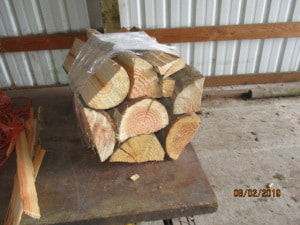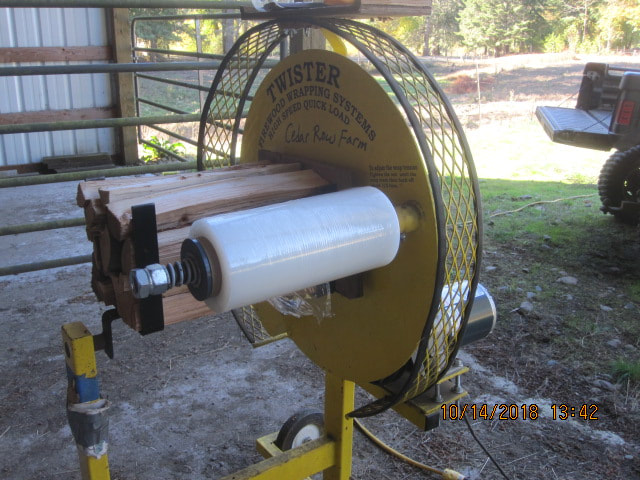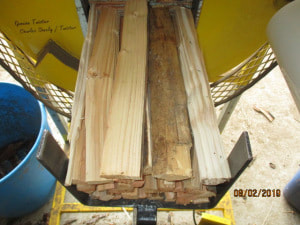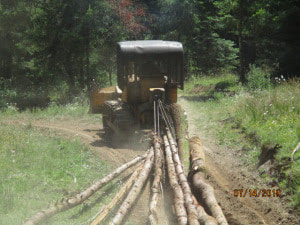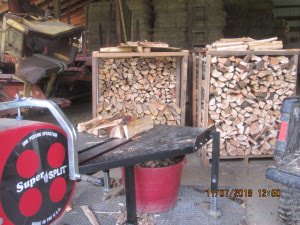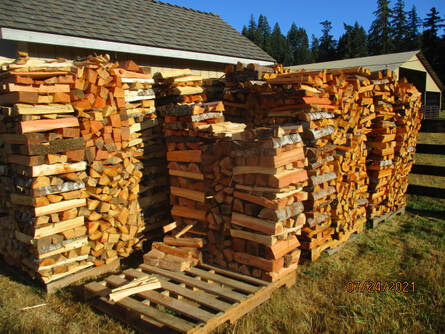 By Susan Schmidlin Back on June 1st, I began building my outdoor pile for drying wet wood to standards of 17 degrees of moisture or less before bundling for my firewood project with OWC. Oh how modest that single pallet of wood looked. Along comes Gator (our ATV) with load after Gator load of really green, freshly processed wood from the logs that Mike has been cleaning up in the forest. It is not a quick process, usually only one load a day several times a week since I sort out all wood that is already dry and ready for bundling. The dry wood is stacked in cribs ready to be set alongside the bundler and wrapped up snug along with the label, but that is a completely different story. This picture shows the green stack has grown by five pallets so far with more to come. During more conventional years, this stack would be across the river in long rows while the drying process (months of curing) takes place. With the bull barn in a wild frenzy of preparing for remodel, we wanted this wood to be closer to an area where we could get to it rather that moving during inclement weather and reducing the amount of wet in the form of mud being tracked into the new workspace as it is being made. It takes a lot of pre-planning in order to have a supply available for processing and delivery when it is needed. This outdoor stack ( and I am really outrageously hopeful here) should grow to twice the side it currently is. I am looking for a minimum of 6 cord of wood for my backup supply after my 6 to 10 cord of dry, cured wood is bundled and delivered. I have a lot of work to do to get this lofty goal accomplished before fall. 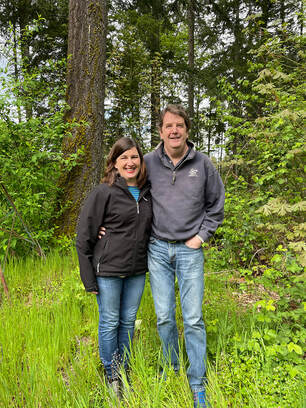 Laurie & Jim Marsh on their tree farm Laurie & Jim Marsh on their tree farm By Laurie Schroeder Marsh On the Schroeder Home Place for the last year, family members of MOSH Tree Farm have been busy with numerous woodland activities: After planting over 3000 Western Red Cedar seedlings in 2018, we have been busy whacking back nasty invasives such as blackberry and poison oak, scarifying around each tree to allow for optimal growth. We have re-established trails throughout the property that our grandparents originally maintained and named, which has allowed us easier access to our baby trees. It has been fun during COVID to connect with family and friends outdoors by walking our mile of trails throughout the property, while we share our enjoyment of the abundant plant and wildlife friends such as deer, bobcat, and the Great Horned Owl we have named Stanley, among others. We have yarded logs with the Logrite ATV and Junior arches, turning downed logs leftover from thinning into firewood, producing, selling and delivering over 40 cords of bulk firewood in a four-month period of time through OWC and a roadside sign near our home. Our Supersplit has been humming, busting through any round we can get on the table. Now we are focusing on pulling fuel from the forest floor before the poison oak leaves appear, trying to leave intentional wildlife habitat locations. Our intention is to minimize the risk of fire. Our property borders a busy road where cigarette butts are dropped and sparks from vehicles on the road could start a fire. We are thankful for the support of fellow OWC members who have provided advice, education and networking, offered trailers, free wood for firewood and the camaraderie of fellow small woodland owners. 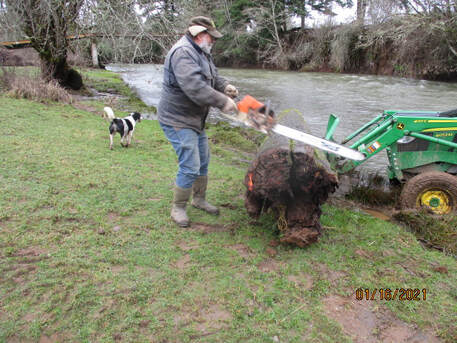 By Susan Schmidlin I have always Poo-Poo-ed the thought of having a clone (I get into enough trouble with just me) but that I needed an extra set of hands to get work done. Even though that could probably get me into trouble also. This week on the farm we had a visitor that supplied the extra set of hands and was willing to help get us caught up on all the production end of the firewood project as well as several other sidelined tasks that had been piling up. Each day we worked on the firewood. Saws were running, as well as the tractor for moving cribs. The Super Split was working overtime with all three varieties of wood products, firewood, premium hardwood and kindling. The Gator was being used to shuffle the cut 16-inch pieces to the splitter in the barn. It was a lot of activity for one week, but we got all the 9 of the cribs emptied of wood and re-stacked. Now the garage once again loaded with 7 of those cribs in the final drying stages for the wood. We have the large garden trailer also in the garage filled to the brim with kindling. 2 of the cribs are set in the bull barn and ready to begin the week of bundling. With the threat of colder weather and possibly snow in the forecast, this flurry of activity at the farm came at a perfect time. The visitor is now gone but the help we got from the extra set of hands (and strong back, and willingness to jump right in) is invaluable. 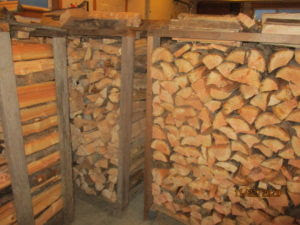 By Susan Schmidlin Last week the garage was loaded with bins, racks and buckets full of kindling that needed a little drying before getting bundled up as one of the three varieties for the firewood project. As soon as they were ready to go, we cleaned out the garage and wrapped all the kindling. It was a good thing that it dried in time because we needed to move the pickup into that same bay in order to load it in time for a delivery. Once the truck was on the road, Mike started refilling the space with cribs. Now the garage is full of half-cord cribs of firewood of the regular fir and the premium hardwood varieties. Several are just days away from being dry enough to bundle, a couple of the cribs will be in the garage another week or two. With the demands at an all-time high for our little Co-Op, we are scrambling to be able to produce enough bundles to supply our outlets. It is a constant battle to have enough wood racked up to finish the drying process, have new bundles wrapped and ready, getting the racks moved out of the garage for loading, then refilling the garage for the next go-round. Read this and other by Susan at https://schmidlinangusfarms.com/in-the-garage. 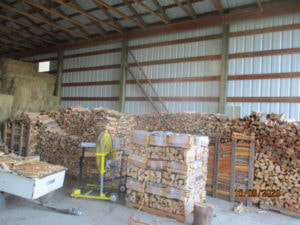 By Susan Schmidlin We had a couple of weeks off from delivering firewood because of the burn ban, terrible wildfires and thick smoke. Just as the rain moved into the area, we got busy getting as much wood as we could stacked into the bull barn so we would have a bit a supply to take us into fall. It is a tricky dance we do with space. We did not build the barns with the thought of producing firewood bundles so any available square footage is premium real estate. I commandeered the far wall of the barn from the stack of hay bales to the open side of the structure. We currently have about ten cord of fir wood, kindling and hardwood that has been split into pieces that are dry and ready to bundle. But the pile will dwindle quickly if we don’t get busy getting some more split wood undercover where it can complete the seasoning process. Already the fall orders have begun to pick up and the OWC is busy with deliveries each week. Anytime that is not being spent in the barn bundling will put me out at the log decks, cutting and splitting the wood that will be future bundles. Read the original post here and more at Schmidlin Angus Farms. 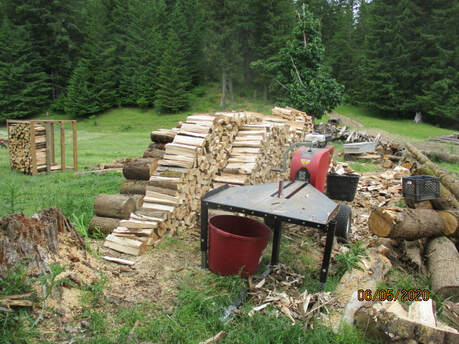 By Susan Schmidlin The reason I talk about the gadget I use to split firewood in a lot of the farm stories is because the Super Split is an incredible addition to my wood making equipment. I have also had questions about the equipment. The purchase was easy through the Oregon Woodland Co-Op (OWC). Both electric and gas-powered versions are available for purchase. A smart customer recently ordered a Super Split with both the gas powered and electric motor so they can be switched out as to what is needed where they are working that session. I happened to purchase the gas motor powered version because I knew I would be working on the side of the river where we do not have electric available. The unit is self-contained and easy to hitch up to the Gator to move it where I need to do the work. A lot of my splitting is done during the wintertime or inclement weather so I like to set up under cover in one of the barns while splitting for ease of stacking the wood pieces for further drying or storage. The unit is easy to hitch up to the Gator to move it where I need to do the work. During nice weather, and when I have the luxury of the herd of cows in a distant pasture so they don’t bother me, I like to set up right next to the log deck where the wood has been cut into 16 inch pieces. I find the unit splits green wood just as easily as dry wood pieces. Because the Super Split uses centrifugal (flywheel) instead of the loud and clumsy hydraulic ramrod force, the splitting is quick and easy. The ergonomic handle on the top takes gentle pressure to engage the plunger for a smooth split. The tabletop design allows the operator a good look at the wood before and after splitting. It is easy to manipulate the wood chunks for the desired split. I find that I can shave off those pesky knots that I missed on the wood as I was cutting the pieces with smooth perfection. Splitting a cord of wood can go quickly. It takes longer to grab and place the piece on the Super Split than it does to chop it into the sizes for bundling. Splitting a 16 inch chunk of wood into kindling is so much faster and safer than using an ax. I prefer to split the wood chunk into slabs first then lay the slabs on top of each other and slice of several kindling pieces off at the same time. For those who are looking for more information on the Super Split or other equipment the OWC website is the place to go. This post was originally published here: https://schmidlinangusfarms.com/questions-about-the-super-split/ OWC member Roy Anderson has created a new video showing the whole process of producing bundled firewood, from thinning trees in the forest to delivering finished bundles to the customer. He shares some useful insights on equipment and methods that make small scale firewood production more efficient. And you’ll see that his whole family is involved, through their small business, Rip City Firewood. Click on the link below to view the video on YouTube. See more videos from Roy here: https://www.youtube.com/user/RipCityFirewood  By Margaret Mills We own a tree farm in southern Clackamas county. The annual timber harvest provides a modest income, but ours is a family partnership with multiple households and we have sought additional sources of revenue in order to benefit more family members, leading us to research various non-timber forest products. These have included foraged wild foods, herbs for medicinal use, craft and floral products, as well as firewood and other traditional ventures. We found the economic potential varies from little “side hustles,” to businesses that could, potentially, rival the sale of timber from our property. Cones were not a new product for us. In the 1950’s and 60’s our family collected Douglas fir cones to sell for seed, but seedlings for reforestation are produced differently now, and seed-cones are no longer the market they were. My adult daughter and I recently began experimenting with marketing forest craft and floral products. In addition to selling boughs for holiday décor through the Oregon Woodlands Cooperative, we decided to add Douglas fir cones to our list of potential craft products. Fir cones are easily accessible, crunching underfoot on most walks through the property and littering the driveway near the house. We collected a few hundred cones in a relatively short time, and learned to divest them of bugs and dirt by washing them in a sink of warm water with a little mild soap and a dash of vinegar, then drying them at a very low temperature (200?F) in the oven for a half hour. Cones close up when subjected to water, so ours were left to dry and open completely for another week or so in a cardboard box or on our improvised “drying trays,” (cookie sheets commandeered from the kitchen). We listed the best of the dried cones for sale in bulk lots in our Etsy shop. While waiting for orders we foraged for other species on our property and brought home hundreds of tiny hemlock cones. We also have stands of young Ponderosa Pine but did not believe they were producing cones. Upon closer inspection, to our delight, we found a bounty of beautiful pinecones hiding like Easter eggs in the tall grass beneath the trees. We also visited a cluster of White Pine deep in the forest resulting in a large tote of long White Pine cones. All but the White Pine were cleaned, dried and listed in the Etsy store for sale to crafters. However, we had chosen to market craft items because we love to create, so while we waited for the orders to start pouring in, we began experimenting with our stock. We learned to bleach some of the cones, turning them into a soft off-white or beige color, we cut cones apart to make faux “flowers,” and we began (couldn’t help ourselves) making things, including wreaths. We discovered wreaths made of pine or fir cones are popular in a rustic or shabby chic style of décor. One design in particular became a favorite, and we embellished it with hemlock cones and acorns. The acorns, from oak trees, are not available on our property, but we easily sourced them elsewhere. We began experimenting with paint. Cones wreaths in a variety of colors with acorns painted gold or silver began to adorn our wall space. We learned not to leave the cones too long in the oven (they will burn), or to layer them too deep to dry (they will mold). And we learned not to leave painted acorns on the outdoor workbench the day I looked up from my desk to see a blue jay with a golden acorn in his beak. I ran out to discover that more than half my 30 painted acorns were missing. The cone wreaths went up in the Etsy store as well, and within a few weeks, during the Christmas holidays, we made some sales. The interest in our own creations was an unexpected development, but we continue to get some interest in the bulk craft supplies as well, so we keep both options open. This little business enterprise is barely out of the “hobby” stage, very much in infancy, but we’ve noted several encouraging changes for rural entrepreneurs since the long-ago time when we collected seed-cones to sell to the local timber company, or cascara bark at the local feed store. While the traditional marketing avenues for our type of product include friends and family, craft shows, our farmers’ market, and an art and craft consignment store, new ways of reaching markets have developed that increase our chances of reaching customers. We sold our boughs through OWC, for example, rather than having to find our own buyers. However, the real game changer is the internet. Not only do we sell mostly online, we are learning to use various social media to create interest in both our craft supplies and our creations. We have a Facebook page, and have made use of Facebook ads. For arts and crafts, Pinterest is ideal and has produced the best results, leading to a very discernable jump in visitors to our Etsy store. There is, admittedly, a learning curve on how to best market online, the use of social media, photography and other skills, but the potential for reaching the customers seeking your unique forest product is very encouraging, and sometimes surprising. I found a lot of interest in our rustic décor items coming from New York City. In fact, my first sale was to New York, a demographic not easily accessible from rural Oregon without the internet. Whether this will be a lucrative business remains to be seen, but so far it has been a lot of fun, both exploring the farm for potential craft materials and inventing new ways to use them, ways that potentially may bring a bit of our wild forestland to far-off urban dwellers. And that seems worth doing. By Susan Schmidlin
By cutting dry wood, logs that have been aged through the winter, spring and some summer months, we are able to avoid a lot of the drying and curing process since nature has done most of that work already. We purchased the gas-powered splitter from OWC because members get a discount from regular retail. Using the Super Split, we are able to easily move the splitter from one area of cut wood chunks to another or into the barn where we bring the wood to it during wet weather. Our property is farm and forestland, the firewood business is not a full time project. We fit in the different processes of the firewood project just like the way we utilize a small section of each of the three barns, in increments and out of the way of cows, hay storage and large equipment. One barn is for splitting the chunks and loading the cribs, another is for storage of filled cribs for drying and curing, and the third barn is for the actual bundling process. With the wood split into manageable pieces, dried to be below 18% moisture and moved to the third barn, we begin the bundling. I had the pleasure to practice with some of the Co-op members to get the hang of wrapping. Stacking the pieces of wood into a metal cradle so that the bundle ends up firmly wrapped is a skill that is acquired easily if first shown then practiced. We borrowed a Twister from a member for our first cord of firewood until we decided to purchase our own when we realized that the process by hand was way too cumbersome and the outcome was not a quality, firm bundle. We purchased the Twister machine also from the OWC used, from a member who didn’t need it anymore. The wrap is also purchased through the Cooperative at much better prices than one can get retail. This machine is electric powered which is why we bundle our wood in the one barn that has electricity. Here is a great hint for anyone who is trying to bundle firewood. To protect my hands from splinters, I use fabric gloves that have a faux-leather palm. The leather lets me grasp the wrap easily and hold the bundle firm as the arm swings the wrap around and around while the fabric makes it easy to smoothly extract my hand from under the wrap without stopping the machine’s flow. My preferred brand of choice is digz Planter gloves and I found these at my local Bi-Mart store, the fairly thin fabric and leather is best to have the dexterity needed to manipulate the fragile wrap. I keep one pair by the wrapper to be used strictly during bundling process. By setting the crib of firewood close by with several containers of varying sizes of smaller pieces, one person could load and wrap bundles easily. Most of the time, we are out in the barn as a family so one person can fit wood pieces into a cradle while another slips a filled cradle through the arms of the wrapper to pull the empty cradle away before labeling and wrapping the bundle. A third person pulls the wrapped bundle off the Twister to stack them neatly onto a pallet. For demonstration, this procedure is how I do the bundling when I am stacking the wood into place and wrapping by myself. The wrap is slipped onto the wrapping arm and bolted into place. The tightness of the bolt is how the tension is controlled. If the bolt is too tight, the wrap will break instead of going around the bundle four times. If it is too loose, the bundle will not be wrapped firm and will fall apart easily. Wood is stacked into the cradle, in this case I am showing kindling that is needed for the firewood order this particular week. The wood is stacked tightly, I like to jostle it a bit and tamp it down to make sure there are no hidden gaps. The wood is stacked to proper height to get the correct volume amount. For firewood, the pieces are stacked flush to the top of the cradle arms, for kindling the wood is stacked to one inch below the top and with a flat top surface. The wrap film is unwrapped a couple of feet and tucked around the top of the wood. A foot pedal at the base of the Twister is used to power the swinging arm with wrap. The arm swings clockwise around the bundle. I use my gloved hands to hold the pieces in place as the arm swings the wrap around. I prefer to get one full rotation of wrap around the bundle before placing the OWC label on the top of the wood so I can let the arm rotate three more times before cutting off wrap and smoothing down the edges. This bundle did not get squared correctly in the cradle. The end result was a more rounded bundle that does not sit flat. It would not stack well on the pallet, in the pickup for delivery or in the store with the other bundles. This bundle was taken apart, re-stacked and re-wrapped for that professional look that is needed for the customers. Stay tuned for the next in the series of So You Think You Can Wood. https://schmidlinangusfarms.com/sytycw-story-4-bundling/#more-8659 By Susan Schmidlin
We begin in the woods. Unlike clear-cuts that make huge gaps in the landscape, we selectively thin out trees that are too thick, sick, dying or are broken to let the rest of the trees grow to their potential. Our stand of timber does not decrease in mass board feet each year from this process and in some years, where we do not do much logging, actually increases in volume. We are also planting new seedlings each year with the expectation of 50 to 100 years from now having the forest land can continue with our set protocol. Trees with limbs removed are hauled down the hill to the landing at the base of the hill. The log deck can be as big as a log truck load of logs and much longer in length. Since we have the outdoor space available, we like to let the deck of trees stay piled up in a deck until the next year, to begin and if possible, to complete the drying/curing process. We have cut both dry and green wood for our firewood project and have found that it is much easier to track the progress of wood that is already dry and cured rather than the extra step of recording dates along with moisture content. On those rare occasions during the winter time when the drying process is not proceeding quickly enough, we have had to move the split wood into the heated garage and set up fans and de-humidifiers to dry out excess moisture but we prefer not to have to go to all that work. The tools for cutting the wood are simple. A good chain saw with sharp chain and a way to mark where to cut each length of wood to assure each piece is 16 inches. We prefer to use good old chalk to mark the wood rather than using commercial pencils that have a oil or wax base with coloring because of the marks it leaves on the wood. Chalk dissipates easily and doesn't leave a residue. A retractable tape measure with 16 inch increments highlighted in bold red so I can see it easily is handy because the metal tab at the tip sits securely on the end of the log and eight feet of log can be marked quickly and efficiently by one person. I prefer to mark enough logs at one time to keep the saw busy for a full tank full of gas (about a half hour). This saves on time and cranking energy during the saw starting process. I find that I can cut nearly a quarter of a cord a wood at a time by using this technique. I also try to remove any knots or partial knots that were left on the logs during the cutting (any that I miss can be removed during the splitting procedure). After the wood is cut into the 16 inch lengths it needs to be split into sizes acceptable for bundles. This is where the Super Split that we purchased from OWC comes in handy. 4 inches and smaller is the guide on this and I like to have a couple of pieces of this size mixed in with smaller sizes to make the wood stackable into square bundles. Once the wood is split, we stack it into cribs to keep it clean, moveable and easy to grab from while processing into bundles. Our barn space is limited to small areas in three different barns so the moveable cribs make it easy to tractor a crib from the splitting barn to the drying barn then out to the bundling barn for each of the processes. We use a moisture meter to check the dryness of the wood pieces by sticking the probes into the wood on the end to get a sense how the wood is doing. To get an accurate reading, the wood will be split and the moisture content in the center of the wood is checked. A moisture meter can be purchased at most hardware/tool/logging shops, the one I use is Pittsburgh brand and is a small, easy use tool to assure quality cured wood. The homemade cribs are a creation that Mike came up with using a standard wood pallet for a base so the forks of the front loader fit nicely. Each crib holds a half cord of split firewood capable of making about 70 bundles of finished firewood. We started off our firewood project with eight cribs and assumed that we would continue to fill them back up with split wood as we worked the wood into bundles. Stay tuned for the next installment in the Series, So You Think You Can Wood https://schmidlinangusfarms.com/wood-3/#more-8639 |

